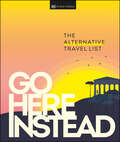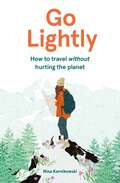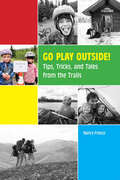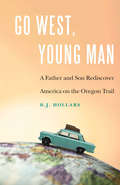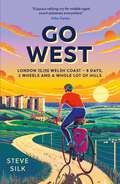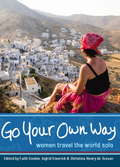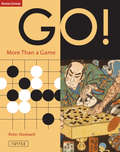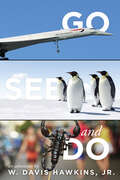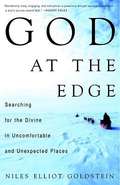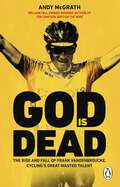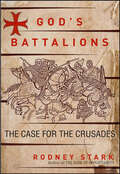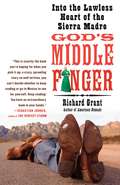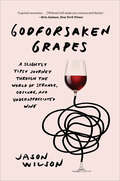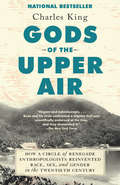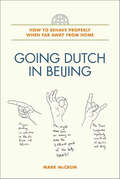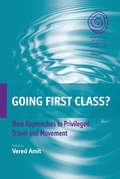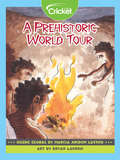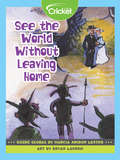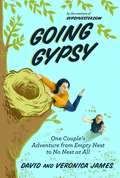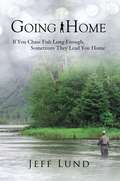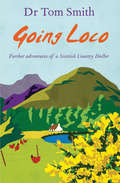- Table View
- List View
Go Here Instead: The Alternative Travel List
by DK EyewitnessBursting with beautiful photography, this alternative bucket list takes some of the world's best-known sights, experiences and destinations – everything from over-visited national parks to crowded museums – and reveals more than 100 fascinating alternatives. Planning a trip to Rome&’s Colosseum? Why not try the ancient amphitheatre in Nîmes instead. A visit to the Grand Canyon is on everyone&’s bucket list – but how about adding Namibia&’s spectacular Fish River Canyon to yours? And while Japan&’s cherry blossoms are hard to beat, the seasonal display of hydrangeas in the Azores is just as beautiful.Featuring expert advice and practical tips, Go Here Instead will open your eyes to a wealth of new, and more sustainable, travel ideas. We&’ve organized the book by types of trip, so whether you&’re a wannabe art critic, an outdoor adventurer or you&’re into your history, this epic bucket list has an alternative adventure for you. So, why not give Machu Picchu a break and travel beyond the crowds. Go Here Instead: The Alternative Travel List is your ticket to the trip of a lifetime. Inside Go Here Instead: The Alternative Travel List you will find:- 100 entries each focusing on an alternative to a well-known destination/sight/experience - Stunning photography throughout with color-coded maps and chapters- Stylized locator maps pinpointing the alternative sights, experiences and destinations.- A beautifully designed gift book that showcases inspiring alternatives to the world&’s most popular sights, experiences and destinations- Covers: Architectural and Historical Sights, Festivals and Parties, Great Journeys, Architectural Marvels, Natural Wonders, Art and Culture and Cities About DK Eyewitness: At DK Eyewitness, we believe in the power of discovery. We make it easy for you to explore your dream destinations. DK Eyewitness travel guides have been helping travelers to make the most of their breaks since 1993. Filled with expert advice, striking photography and detailed illustrations, our highly visual DK Eyewitness guides will get you closer to your next adventure. We publish guides to more than 200 destinations, from pocket-sized city guides to comprehensive country guides. Named Top Guidebook Series at the 2020 Wanderlust Reader Travel Awards, we know that wherever you go next, your DK Eyewitness travel guides are the perfect companion.
Go Lightly: How to travel without hurting the planet
by Nina KarnikowskiThis sustainable travel handbook inspires readers to explore our fascinating planet without causing it further harm. Ten chapters help you go lightly, including how to choose the least impactful methods of travel, how best to protect wildlife, how to pack with more consideration and how to implement mindful practices into each travel day, Go Lightly gives the reader a tool kit of fresh ideas for travelling more consciously. The book also covers eco-friendly activities including biking, boating and camping, and introduces us to some of the world's most inspiring eco-adventure pioneers.
Go Lightly: How to travel without hurting the planet
by Nina KarnikowskiThis sustainable travel handbook inspires readers to explore our fascinating planet without causing it further harm. Ten chapters help you go lightly, including how to choose the least impactful methods of travel, how best to protect wildlife, how to pack with more consideration and how to implement mindful practices into each travel day, Go Lightly gives the reader a tool kit of fresh ideas for travelling more consciously. The book also covers eco-friendly activities including biking, boating and camping, and introduces us to some of the world's most inspiring eco-adventure pioneers.
Go Play Outside!: Tips, Tricks, and Tales from the Trails
by Nancy FrescoHaving children doesn’t mean that you can’t enjoy every season in the great outdoors—even if you happen to live in the middle of Alaska. Whether you’re biking eighty miles into the heart of Denali National Park, cross-country skiing to a remote cabin, or merely enjoying the mud on the banks of the Chena River in downtown Fairbanks, fun for all ages abounds, with a little preparation and the right mindset. Using a deft mixture of storytelling and practical pointers, this guidebook offers advice and encouragement to families—those who live in Alaska, as well as those in less extreme climates and locales. Organized by the age of the young adventures, from days-old infants to independent teens, each section invites readers to learn from the humorous real-life adventures and misadventures of the author, her husband, and their twin girls. Weaving in the kids’ advice in their own words, this guide covers challenges ranging from unexpected hailstorms to very-much-expected mosquitoes. Tips include everything from how to avoid moose, to how to get out in the rain, to the benefits of setting big kids free to explore. This family’s enthusiastic, joyful, and often hilarious tales offer the impetus and the tools to encourage new parents—or more experienced parents, or anyone who loves kids —to go play outside.
Go West, Young Man: A Father and Son Rediscover America on the Oregon Trail
by B.J. HollarsAt the sound of the bell on the last day of kindergarten, B.J. Hollars and his six-year-old son, Henry, hop in the car to strike out on a 2,500-mile road trip retracing the Oregon Trail. Their mission: to rediscover America, and Americans, along the way. Throughout their two-week adventure, they endure the usual setbacks (car trouble, inclement weather, and father-son fatigue), but their most compelling drama involves people, privilege, and their attempt to find common ground in an all-too-fractured country. Writing in the footsteps of John Steinbeck&’s Travels with Charley, Hollars picks up the trail with his son more than half a century later. Together they sidle up to a stool at every truck stop, camp by every creek, and roam the West. They encounter not only the beauty and heartbreak of America, but also the beauty and heartbreak of a father and son eager to make the most of their time together. From Chimney Rock to Independence Rock to the rocky coast of Oregon, they learn and relearn the devastating truth of America&’s exploitative past, as well as their role within it.Go West, Young Man recounts the author&’s effort to teach his son the difficult realities of our nation&’s founding while also reaffirming his faith in America today.
Go West: London to the Welsh Coast – 8 Days, 2 Wheels and a Whole Lot of Hills
by Steve SilkWhat would happen if you got on a bike in central London and didn't stop riding until you hit the Welsh coast? Steve Silk, the best-selling author of The Great North Road, provides the answer over eight days, 300 miles and rather a lot of hills. Enriched with history, Go West is a must for anyone who has ever dreamed of a cycling adventure.
Go Your Own Way: Women Travel the World Solo
by Christina Henry de Tessan Faith Conlon Ingrid EmerickThere is nothing quite like hitting the road by yourself to awaken your senses, sharpen your mind, and build your confidence. In twenty-three beautifully crafted essays, women recount the thrills of traveling solo.Despite threat-assessment levels and airport-security hassles, women of all generations are traveling more freely and independently than ever before. In that go-for-it spirit, Go Your Own Way spans the globe: adventure diva Holly Morris finds herself lost in the jungles of Borneo, alone with her thoughts and a cold-blooded companion; Lara Triback's quest to learn the tango takes her to the late-night dance floors of Buenos Aires; Stephanie Griest finds female friends invaluable in her journey through Uzbekistan; and Amy Balfour recounts a hilarious trek up Yosemite's Half Dome.The writers in Go Your Own Way pay tribute to the empowerment of independent adventure and discovery, offering up the perfect antidote for today's climate of fear and international discord. All the while, they show that alone doesn't have to mean lonely.
Go de Rass to Sleep (A Jamaican translation): (A Jamaican translation)
by Adam MansbachNamed one of the 20 Greatest New Father's Day Gifts by Advocate.com!"No matter what the country or the language, parents all over the world--loving, frustrated, exhausted parents--know what Adam Mansbach means. Since 2011, his comically obscene picture book has sold more than 1.5 million copies in dozens of languages from Afrikaans to Japanese to Nynorsk. And later this year, his little book will venture into new territory with a Jamaican patois translation: 'Go de R-s to Sleep.'"--The Washington Post/Style Blog"This version of Adam Mansbach's profane, affectionate, and radically honest book will remind whole new audiences about the absurdities of parenting. Just don't read it to the kids."--Advocate.com, The 20 Greatest New Father's Day GiftsPraise for Go the Fuck to Sleep:"A new Bible for weary parents."--New York Times"Incredibly appealing."--NPR"A parenting zeitgeist...A phenomenon that has stunned the publishing world and may just redefine the modern 'parenting’ market."--Washington Post"Delightfully obscene."--Newsweek"Nothing has driven home a certain truth about my generation, which is approaching the apex of its childbearing years, quite like this deranged book."--New YorkerThe best-selling Go the F*** to Sleep has been translated into over thirty languages worldwide. Now it is finally translated for Jamaican and other Caribbean parents of the world. Given how many West Indians live in the US and Canada, the market for this book should be broad, but focused mainly on areas with a large Caribbean community.Go de Rass to Sleep is a bedtime book for parents who live in the real world, where a few snoozing kitties and cutesy rhymes don’t always send a toddler sailing blissfully off to dreamland. Profane, affectionate, and radically honest, California Book Award-winning author Adam Mansbach's verses perfectly capture the familiar--and unspoken--tribulations of putting your little angel down for the night. In the process, they open up a conversation about parenting, granting us permission to admit our frustrations, and laugh at their absurdity.With illustrations by Ricardo Cortés, Go de Rass to Sleep is beautiful, subversive, and pants-wettingly funny--a book for parents new, old, and expectant. You probably should not read it to your children.
Go! More Than a Game
by Peter ShotwellInvented 2500-4000 years ago, the game of Go has enthralled hundreds of millions of people in Asia, where it is an integral part of the culture. In the West, hundreds of thousands have learned of its pleasures, especially after the game appeared in a number of hit movies, TV series, and books, and was included on major Internet game sites. By eliciting the highest powers of rational thought, the game draws players, not just for the thrills of competition, but because they feel it enhances their mental, artistic, and even spiritual lives.Go! More Than a Game uses the most modern methods of teaching, so that, in a few minutes, anyone can understand the two basic rules that generate the game. The object of Go is surrounding territory, but the problem is that while you are doing this, the opponent may be surrounding you! In a series of exciting teaching games, you will watch as Go's beautiful complexities begin to unfold in intertwining patterns of black and white stones. These games progress from small 9x9 boards to 13x13 and then to the traditional19x19 size.Go!: More Than a Game, complete with the history of Go as well as essays on Go in culture, is a wonderful introduction to this ancient game.
Go! More Than a Game
by Peter ShotwellInvented 2500-4000 years ago, the game of Go has enthralled hundreds of millions of people in Asia, where it is an integral part of the culture. In the West, hundreds of thousands have learned of its pleasures, especially after the game appeared in a number of hit movies, TV series, and books, and was included on major Internet game sites. By eliciting the highest powers of rational thought, the game draws players, not just for the thrills of competition, but because they feel it enhances their mental, artistic, and even spiritual lives.Go! More Than a Game uses the most modern methods of teaching, so that, in a few minutes, anyone can understand the two basic rules that generate the game. The object of Go is surrounding territory, but the problem is that while you are doing this, the opponent may be surrounding you! In a series of exciting teaching games, you will watch as Go's beautiful complexities begin to unfold in intertwining patterns of black and white stones. These games progress from small 9x9 boards to 13x13 and then to the traditional19x19 size.Go!: More Than a Game, complete with the history of Go as well as essays on Go in culture, is a wonderful introduction to this ancient game.
Go, See, and Do: An Adventure
by W. Davis Hawkins Jr.A lifelong adventurer shares his fascinating story in this memoir of travel, life in Japan, and special assignments from the White House. Davis Hawkins lives a life of adventure and travel, approaching each opportunity with the mantra to &“Go, See, and Do.&” He chronicles his life through this lens, starting with his southern California upbringing before moving to Japan at an impressionable age. He experienced a changing America and East Asia landscape in the mid-twentieth century living abroad. These moments impacted his life through his military service and directed him to a successful financial and consulting careers overseas. Hawkins continued traveling, embracing any opportunity to visit different cultures. He visited more than eighty countries spanning all seven continents, finding human shrunken heads in Borneo, trekking in the Himalayas and the Amazon jungle, camping in the Gobi Desert, dining at the US State Department, couriering for the President of the United States, receiving a US congressional subpoena, surviving a military coup, and much more.
God at the Edge: Searching for the Divine in Uncomfortable and Unexpected Places
by Niles Elliot GoldsteinHere is a book about adventure, raw experience, and facing inner demons. Niles Elliot Goldstein is a young rabbi who sets out to find God in tough and often scary situations: dogsledding above the Arctic Circle, taking the Silk Road into Central Asia without a visa, being chased by a grizzly bear, cruising with DEA agents through the South Bronx, and spending a night in jail in New York City's Tombs. He explores the connections between struggle and growth, fear and transcendence, and uncertainty and faith, seeking the boundary where the finite meets the Infinite. Goldstein is not alone in making this kind of pilgrimage. There has always been a strong tradition of seekers who looked for revelation outside conventional religious settings and encountered God in moments of anguish, terror, and pain. Goldstein juxtaposes his own experiences with those of some of the great historical figures of Judaism and Christianity -- Jonah and St. John of the Cross, Moses Maimonides and Julian of Norwich, Nachman of Bratslav and Martin Luther -- as well as lesser known mystics and preachers, and he discovers, as they did, that it can sometimes take a journey to the edge to recognize God's presence in our lives.
God is Dead: SHORTLISTED FOR THE WILLIAM HILL SPORTS BOOK OF THE YEAR AWARD 2022
by Andy McGrath•SHORTLISTED FOR THE WILLIAM HILL SPORTS BOOK OF THE YEAR AWARD 2022••A SPORTS BOOK OF THE YEAR BY THE TIMES AND THE GUARDIAN•The remarkable untold story of the mercurial cycling prodigy Frank Vandenbroucke, written by William Hill award-winning author Andy McGrath.They called him God. For his grace on a bicycle, for his divine talent, for his heavenly looks. Frank Vandenbroucke had it all, and in the late Nineties he raced with dazzling speed and lived even faster.The Belgian won several of cycling's most illustrious races, including Liège-Bastogne-Liège, Paris-Nice and Ghent-Wevelgem. He was a mix of poise and panache who enthralled a generation of cycling fans. Off the bike, he only had one enemy - himself. Vandenbroucke dabbled in nocturnal party sessions mixing sleeping pills and alcohol and regularly fell out with team managers. By 1999 his team had suspended him and this proved to be the start of a long, eventful fall from grace. Depression, a drug ban, addiction, car crashes, divorce and countless court appearances subsumed his life. He threatened his wife with a gun. He tried to commit suicide twice. And when police found performance-enhancing drugs at his house, Vandenbroucke said they were for his dog.It seemed he had finally learned from his mistakes. Then, on 12 October 2009, aged just 34, Vandenbroucke was found dead in a hotel room in Senegal.Guided by exclusive contributions from his family, friends and team-mates, William Hill award-winning author Andy McGrath lays bare Vandenbroucke's chaotic, complicated life and times. God is Dead is the remarkable biography of this mercurial cycling prodigy.
God's Battalions: The Case for the Crusades
by Rodney StarkIn God’s Battalions, distinguished scholar Rodney Stark puts forth a controversial argument that the Crusades were a justified war waged against Muslim terror and aggression. Stark, the author of The Rise of Christianity, reviews the history of the seven major crusades from 1095-1291 in this fascinating work of religious revisionist history.
God's Middle Finger: Into the Lawless Heart of the Sierra Madre
by Richard GrantFrom the acclaimed author of Dispatches From Pluto and Deepest South of All, a harrowing travelogue into Mexico&’s lawless Sierra Madre mountains.Twenty miles south of the Arizona-Mexico border, the rugged, beautiful Sierra Madre mountains begin their dramatic ascent. Almost 900 miles long, the range climbs to nearly 11,000 feet and boasts several canyons deeper than the Grand Canyon. The rules of law and society have never taken hold in the Sierra Madre, which is home to bandits, drug smugglers, Mormons, cave-dwelling Tarahumara Indians, opium farmers, cowboys, and other assorted outcasts. Outsiders are not welcome; drugs are the primary source of income; murder is all but a regional pastime. The Mexican army occasionally goes in to burn marijuana and opium crops—the modern treasure of the Sierra Madre—but otherwise the government stays away. In its stead are the drug lords, who have made it one of the biggest drug-producing areas in the world. Fifteen years ago, journalist Richard Grant developed what he calls "an unfortunate fascination" with this lawless place. Locals warned that he would meet his death there, but he didn't believe them—until his last trip. During his travels Grant visited a folk healer for his insomnia and was prescribed rattlesnake pills, attended bizarre religious rituals, consorted with cocaine-snorting policemen, taught English to Guarijio Indians, and dug for buried treasure. On his last visit, his reckless adventure spiraled into his own personal heart of darkness when cocaine-fueled Mexican hillbillies hunted him through the woods all night, bent on killing him for sport. With gorgeous detail, fascinating insight, and an undercurrent of dark humor, God's Middle Finger brings to vivid life a truly unique and uncharted world.
Godforsaken Grapes: A Slightly Tipsy Journey through the World of Strange, Obscure, and Underappreciated Wine
by Jason WilsonA New York Times and Smithsonian Magazine best book, this &“genial excursion&” to little-known wine destinations &“will make you curious and thirsty.&” (Eric Asimov, The New York Times). Eighty percent of the wine we drink is made from only twenty grapes. Yet, there are nearly 1,400 known varieties of wine grapes in the world—from altesse to zierfandler. In Godforsaken Grapes, Jason Wilson looks at how that came to be and embarks on a journey to discover what we miss. Stemming from his own growing obsession, Wilson moves far beyond the &“noble grapes,&” hunting down obscure and underappreciated wines from Switzerland, Austria, Portugal, France, Italy, the United States, and beyond. In the process, he looks at why these wines fell out of favor (or never gained it in the first place), what it means to be obscure, and how geopolitics, economics, and fashion have changed what we drink. A combination of travel memoir and epicurean adventure, Godforsaken Grapes is an entertaining love letter to wine. &“You&’ll walk away with a better understanding of the wine industry and an itch to book a ticket to destinations you&’ve never heard of before.&” —Imbibe Magazine &“Funny, enlightening [and] prodigiously researched.&” —San Francisco Chronicle &“Wilson offers a spirited, highly personal argument for drinking more adventurously.&” —Punch &“A delightful dive into more esoteric grapes.&” —Minneapolis Star-Tribune &“Wonderful . . . [you&’ll] never order another pinot noir again.&” —Tom Bissell, author of Apostle and The Disaster Artist &“Original, obsessive, and wildly insightful. Drink it down!&” —Andrew McCarthy, actor, director, and author of the New York Times bestselling travel memoir The Longest Way Home
Gods of the Upper Air: How a Circle of Renegade Anthropologists Reinvented Race, Sex, and Gender in the Twentieth Century
by Charles KingNEW YORK TIMES BESTSELLER2020 Anisfield-Wolf Book Award WinnerFinalist for the National Book Critics Circle AwardFrom an award-winning historian comes a dazzling history of the birth of cultural anthropology and the adventurous scientists who pioneered it—a sweeping chronicle of discovery and the fascinating origin story of our multicultural world.A century ago, everyone knew that people were fated by their race, sex, and nationality to be more or less intelligent, nurturing, or warlike. But Columbia University professor Franz Boas looked at the data and decided everyone was wrong. Racial categories, he insisted, were biological fictions. Cultures did not come in neat packages labeled "primitive" or "advanced." What counted as a family, a good meal, or even common sense was a product of history and circumstance, not of nature. In Gods of the Upper Air, a masterful narrative history of radical ideas and passionate lives, Charles King shows how these intuitions led to a fundamental reimagining of human diversity. Boas's students were some of the century's most colorful figures and unsung visionaries: Margaret Mead, the outspoken field researcher whose Coming of Age in Samoa is among the most widely read works of social science of all time; Ruth Benedict, the great love of Mead's life, whose research shaped post-Second World War Japan; Ella Deloria, the Dakota Sioux activist who preserved the traditions of Native Americans on the Great Plains; and Zora Neale Hurston, whose studies under Boas fed directly into her now classic novel, Their Eyes Were Watching God. Together, they mapped civilizations from the American South to the South Pacific and from Caribbean islands to Manhattan's city streets, and unearthed an essential fact buried by centuries of prejudice: that humanity is an undivided whole. Their revolutionary findings would go on to inspire the fluid conceptions of identity we know today. Rich in drama, conflict, friendship, and love, Gods of the Upper Air is a brilliant and groundbreaking history of American progress and the opening of the modern mind.
Going Dutch in Beijing: How to Behave Properly When Far Away from Home
by Mark McCrumWhat to do and what not to do when traveling almost anywhere—an entertainment for the armchair or the intrepid travelerWhy shouldn't you offer to pay for your share of the meal in China? Or use the thumbs-up sign to mean "that's excellent" in Sardinia?Because, of course, despite the ease with which we can now communicate with and visit one another, they still do things differently over there. In China your host will "lose face" if you don't let him pick up the tab. In Sardinia a raised thumb means, literally, "Sit on this!"Going Dutch in Beijing offers a lighthearted and informative guide to everything from first meeting to last rites. Subjects covered include the opening contact between strangers; greetings, gestures, handshakes, and getting names right; as well as more complex traditions and how to behave if you decide to stick around for good.Whether you are heading abroad or staying at home, Going Dutch in Beijing is a delightful and indispensable handbook designed to ensure that your sense of the world is informed and your travel is happy.
Going First Class?
by Vered AmitPeople travel as never before. However, anthropological research has tended to focus primarily on either labor migration or on tourism. In contrast, this collection of essays explores a diversity of circumstances and impetuses towards contemporary mobility. It ranges from expatriates to peripatetic professionals to middle class migrants in search of extended educational and career opportunities to people seeking self development through travel, either by moving after retirement or visiting educational retreats. These situations, however, converge in the significant resources, variously of finances, time, credentials or skills, which these voyagers are able to call on in embarking on their respective journeys. Accordingly, this volume seeks to tease out the scope and implications of the relatively privileged circumstances under which these voyages are being undertaken.
Going Global: A Prehistoric World Tour
by Marcia Amidon LustedA fascinating look at archeological finds in Scotland, South Africa, and Malta that offer clues about ancient civilizations.
Going Global: See the World Without Leaving Home
by Marcia Amidon LustedBefore radio, television, and movies, expositions or world fairs such as the World's Columbian Exposition, the 1901 Pan-American Exposition, and the St. Louis World's Fair offered glimpses into faraway cultures and people.
Going Gypsy: One Couple's Adventure from Empty Nest to No Nest at All
by David James Veronica JamesAlmost every couple faces a "now what?" moment as their last kid moves out of the house. There's a big empty nest looming over this new and uncertain stage in their lives.David and Veronica James chose to look at this next phase of life as a beginning instead of an ending. Rather than staying put and facing the constant reminders of empty bedrooms and backseats, a plan began to develop to sell the nest and hit the highway. But could a homebody helicopter mom learn to let go of her heartstrings and house keys all at once?Filled with a sense of adventure and humor, Going Gypsy is the story of a life after raising kids that is a celebration of new experiences. Pulling the rip cord on the daily grind, David and Veronica throw caution to the wind, quit their jobs, sell their house, put on their vagabond shoes, and go gypsy in a beat-up old RV found on eBay.On a journey of over ten thousand miles along the back roads of America (and a hysterical, error-infused side trip into Italy), they conquer old fears, see new sights, reestablish bonds with family and friends, and transform their relationships with their three grown children from parent-child to adult-to-adult. Most importantly, they rediscover in themselves the fun-loving youngsters who fell in love three decades prior.
Going Home
by Margaret WildHugo is in the hospital and missing his home, until the sounds from the zoo next door take him to far away places. A book that encourages the imagination.
Going Home: If you chase fish long enough, sometimes they lead you home
by Jeff LundIt doesn't matter if you're in the woods every other weekend or every other day. Outdoorsman or angler are broad terms and applies to a large population. However, the title does not encapsulate someone who frequently engages in either. Ultimately, anglers, hunters, hikers, etc., are ordinary people whose lives move from anecdote to anecdote, until life gets serious. An outdoorsman is not immune to failure, complex life decisions, nor are things simpler. Being on the water with a fly rod or in the alpine with a rifle does not provide answers because neither a mountain or a fish can talk. However, when life brings trauma, a fly rod can be the best weapon with which to keep fighting. Going Home is a memoir about fishing, without being just about fishing. It's about a man contemplating direction and his sense of home after he is jerked from his linear journey of a life spent chasing fish.
Going Loco: Further Adventures of a Scottish Country Doctor
by Dr Tom SmithPart memoir, part travelogue, Going Loco takes us on a dizzying journey around the medical world. It is a gripping read, full of the colour and charm of Dr Tom's previous book - this young doctor on the move is great company.
